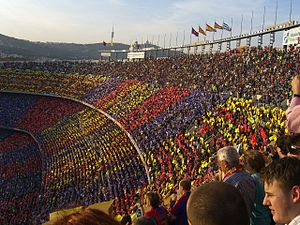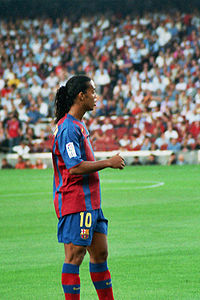- Supporters of FC Barcelona
-
 Barcelona supporters during a match in Camp Nou
Barcelona supporters during a match in Camp Nou
FC Barcelona is a Spanish club based in Barcelona, formed in 1899 by a group of Swiss, English and Spanish players led by Joan Gamper. It has been part of the Spanish top-flight, La Liga, since the league's inception in 1928 and has won La Liga 21 times, along with 25 Copa del Reys and 4 UEFA Champions League victories. The supporters of Barcelona have played an important part in the formation of the club's Catalan identity during the club's 111-year existence. From the authoritarian rule of Spain under Miguel Primo de Rivera in 1923, which later ended with the fascist rule of Franco, various forms of cultural oppression was enacted against Catalonia and FC Barcelona in particular, causing the club to become a symbol of rebellion. After Spain's transition to democracy in 1978, several support groups of FC Barcelona evolved, most notably the Boixos Nois, who later mixed their support of the club with a demand of secession from Spain.
The arrival of Ronaldinho in 2003, and Barcelona's subsequent success in La Liga and Champions League, has been seen as crucial to an increase in the national, and worldwide, fan-base of the club. This development of a larger national fan-base has created friction between the those supporters who wish to secede from Spain and it's non-Catalan Spanish supporters.
There exist three different types of supporters of Barcelona, one is the soci or club-member, who is eligible to vote in the presidential election of the club and other matters. The penyes, who are closely affiliated with the socios are fan-clubs, which in the past have been responsible for large donations to the club. Lastly there are the ordinary fans of the club, the cules, who do not possess any formal membership.
Contents
History
 Ronaldinho has been ascribed with the global rise in supporters during his time at the club.
Ronaldinho has been ascribed with the global rise in supporters during his time at the club.
Before 1909, Barcelona played in various stadia, none of which were owned by the club. On 14 March 1909, the club moved to the Camp de la Indústria which had a capacity of 6,000, it was the first ground owned by the club. Barcelona moved to Les Corts in 1922, which had an initial capacity of 20,000, which was later expanded to 60,000. The top-row of Les Corts was the origin of the nickname culé, derived from the Catalan cul (English: arse), as the spectators at the first stadium, Camp de la Indústria, sat with their culs over the stand. The English author, Phil Ball, notes that "all you could see was row upon row of bums".[1]
In the mid 1940s, the club invented the notion of penyes, a mix between a fan club and a financial support club, during a time when the club was in need of financial and public support in face of the hostility of Francisco Franco's dictatorship. The first Penya Solera, was formed in 1944 by a group of supporters and former players.[2] The penyes would later exhibit their financial in 1953, when they proposed the building of the Camp Nou. Inspiration was drawn from the financial plan Athletic Bilbao used to build San Mamés, were an association of penyes pledged to finance the construction. As a result, the subsequent construction of the stadium put the club into its supporters' hands, giving the penyes political influence over the club, which still lasts today.[3]
During the same period, Franco's oppression of Catalonia caused the relationship between the club and its supporters to change. For the supporters, FC Barcelona became synonymous with Catalonia, a feeling incorporated in the club's Més que un club motto (English: More than a club). The socio-political impulse Visca el Barça (Long live Barça), gradually evolved into Visca el Barça i visca Catalunya (Long live Barça and Catalonia) and was the same as a protest-song against the central government in Madrid.[4]
In 1975, the death of Franco marked the beginning of Spain's transition into a democracy and four years later, Josep Lluís Núñez became the first elected president of FC Barcelona. Since then, the members of Barcelona, called socios, have elected the club president.[5][6]
In the early 1980s, one of the most notorious penyes, the Boixos Nois (English: 'Boxwood boys') was founded.[7] The peña who identified with left-wing separatism, repeatedly demanded the resignation of president Núñez, openly defying his presidency through chants and banners at matches. At the same time, the city of Barcelona experienced a rise in the number of skinheads, who identified with right-wing separatism. The skinheads slowly moved the Boixos Nois' political ideology from liberalism to fascism, which caused fractions within the group.[8] Inspired by British hooligans, the remaining Boixos Nois became violent, which often lead to mass-scale arrests.[9]
According to the protest organisation L'Elephant Blau, formed in part by later-president Joan Laporta in 1998, the former president Núñez promoted the emergence of skinheads among the Boixos and gave them permission to roam freely around the stadium, using them for his own political gain.[10] When Núñez resigned in 2000, his vice-president Joan Gaspart took over as president. Gaspart publicly expressed his sympathies for Boixos Nois, claiming that he would join the group as soon as he resigned as chairman. The comment caused the Boixos Nois members to occasionally be referred to as 'the chairman's boys'.[11]
The same year saw the controversial transfer of the Barcelona vice-captain Luís Figo to arch-rivals Real Madrid. When Figo returned to the Camp Nou in November 2002, the Boixos responded to Figo's perceived treachery by whistling and jeering whenever he went near the ball. The abuse peaked when the Boixos threw a cut-off pig's head next to Figo, while he was taking a corner. The match has since been known in Spain as the "Partido de la Vergüenza" (English: "the Game of Shame"). The match was suspended for 13 minutes by the referee, who took the players off the pitch because of fears for their safety. It ended in a 0–0 draw.[12][13][14]
During the first decade of the new millennium, president Joan Laporta, a supporter of Catalonian nationalism, repeatedly expressed his support of Catalonia's secession from Spain and characterised the club as the symbol for Catalonian separatism. The politicalisation of the club drew criticism from several club members who accused Laporta of alienating Barcelona fans, both within and outside of Catalunya.[15][16] By 2003 Barcelona had 1,200 penyes around the world, causing other Spanish clubs to copy the concept. With each individual peña having different names and rules, it has become a custom in Spain to name a new peña after their favourite player or match, and in turn the player usually attends to the inaugural supper.[2]
In the presidential election of 2010, the rise in club-members during the last seven years caused the campaign to focus on whether to allow votes from non-Catalan members, through internet or post. The balloting committee decided to only allow votes from members who registered at the home stadium on the day of the election.[17]
As of November 2010, membership of the club is no longer open to the public. Only close relatives to current and former FC Barcelona members can join the club as well as previous members with at least a two-year history of membership. This ruling however will not apply to children under the age of 15.[18]
Fan-base
In Spain, approximately 25 percent of the population are Barcelona supporters, this is the second highest percentage behind Real Madrid, who are supported by 32 percent of the population.[19] Throughout Europe many fans regard Barcelona as their second club.[20] Since the 2003–04 season, the club's membership figures have risen from 100,000 to 170,000 socis in September 2009, a 70 percent increase.[21] The sharp rise was attributed to the influence of Ronaldinho and then-president Joan Laporta's media-strategy, which focused on online media in Spanish and English.[22][23] As of June 2010 there are 1,335 officially registered penyes around the world, representing an 11 percent increase since 2003.[24] Many prominent people are recognised as Barcelona supporters, including the previous Pope John Paul II, who was an honorary member, and former prime minister of Spain, José Zapatero.[25][26][27]
References
- Bibliography
- Ball, Phill (2003). Morbo: The Story of Spanish Football. WSC Books Limited. ISBN 0954013468.
- Chadwick, Simon; Arthur, Dave (2007). International cases in the business of sport. Butterworth-Heinemann. ISBN 0750685433.
- Farred, Grant (2008). Long distance love: a passion for football. Philadelphia: Temple University Press. ISBN 1592133746.
- Fisk, Peter (2008). Business Genius: A More Inspired Approach to Business Growth. John Wiley and Sons. ISBN 1841127906.
- Spaaij, Ramón (2006). Understanding football hooliganism: a comparison of six Western European football clubs. Amsterdam University Press. ISBN 9056294458.
- ^ Ball, Phil. p. 111.
- ^ a b Ball, Phil. pp. 110-111
- ^ Ball, Phil. p. 111-112
- ^ Farred, Grant pp. 88-90
- ^ "History part IV". FC Barcelona. http://www.fcbarcelona.com/web/english/club/historia/etapes_historia/etapa_4.html. Retrieved 15 March 2010.
- ^ Ball, Phil p. 85
- ^ Ball, Phil p.112
- ^ Spaaij, Ramón p. 291-292
- ^ Spaaij, Ramón p. 293
- ^ King, Anthony p. 242
- ^ Spaaij, Ramon p. 304
- ^ Edworthy, Sarah (25 November 2002). "Running gauntlet of hate in Spain's gran clasico". London: Telegraph. http://www.telegraph.co.uk/sport/3038466/Running-gauntlet-of-hate-in-Spains-gran-clasico.html. Retrieved 22 August 2010.
- ^ Ball, Phil (24 November 2003). "The Year of the Pig". ESPN. http://soccernet.espn.go.com/columns/story?id=284169&root=europe&cc=5739. Retrieved 22 August 2010.
- ^ Shields, Tom (6 December 2003). "Catalans steel themselves for the worst; Defeat tonight will cap a truly horrific seven days". The Herald. http://pqasb.pqarchiver.com/smgpubs/access/484610481.html?dids=484610481:484610481&FMT=ABS&FMTS=ABS:FT&type=current&date=Dec+06%2C+2003&author=Tom+Shields&pub=The+Herald&desc=Catalans+steel+themselves+for+the+worst%3B+Defeat+tonight+will+cap+a+truly+horrific+seven+days%2C+writes+Tom+Shields+in+Barcelona. Retrieved 18 August 2010.
- ^ Malek, Cyrus C. (1 July 2010). "Spanish Inquisition: What legacy does Laporta leave at Barcelona?". Goal.com. http://www.goal.com/en/news/1717/editorial/2010/06/15/1975818/spanish-inquisition-what-legacy-does-joan-laporta-leave-at. Retrieved 19 August 2010.
- ^ Shobe, Hunter (2008). "Football and the politics of place: Football Club Barcelona and Catalonia, 1975-2005". Journal of Cultural Geography 25 (1): 87–105. doi:10.1080/08873630701822661. http://www.informaworld.com/smpp/content~db=all~content=a790554774.
- ^ Sharma, Ashish (12 June 2010). "Spanish Inquisition: FC Barcelona Prepare For A New Future - Rosell, Ingla, Ferrer Or Benedito". Goal.com. http://www.goal.com/en/news/1717/editorial/2010/06/12/1972462/spanish-inquisition-fc-barcelona-prepare-for-a-new-future-rosell-. Retrieved 20 August 2010.
- ^ FC Barcelona (2 November 2010). "New Membership Registration Process". FCBarcelona.com. http://www.fcbarcelona.com/web/english/noticies/socis/temporada10-11/10/n101028113687.html. Retrieved 6 November 2010.
- ^ "Ficha Técnica" (in Spanish) (PDF). Centro de Investigaciones Sociológicas. May 2007. http://www.cis.es/cis/export/sites/default/-Archivos/Marginales/2700_2719/2705/Es2705mar_A.pdf. Retrieved 8 August 2010.
- ^ Chadwick, Simon; Arthur, Dave. pp.4–5
- ^ Aznar, Víctor (19 September 2009). "El FC Barcelona ya tiene 170.000 socios" (in Spanish). SPORT.es. http://www.sport.es/default.asp?idpublicacio_PK=44&idioma=CAS&idnoticia_PK=646177&idseccio_PK=803. Retrieved 8 August 2010.
- ^ Fisk, Peter. pp. 201–202
- ^ Brott, Steffen. p. 77
- ^ "Penyes". FC Barcelona. http://www.fcbarcelona.com/web/english/penyes/llistat_penyes/llistat_penyes.html. Retrieved 8 August 2010.
- ^ Goff, Steven (29 July 2003). "Barça Isn't Lounging Around; Storied Catalonian Club Plots Its Return to the Top". The Washington Post. http://pqasb.pqarchiver.com/washingtonpost/access/377088531.html?dids=377088531:377088531&FMT=ABS&FMTS=ABS:FT&type=current&date=Jul+29%2C+2003&author=Steven+Goff&pub=The+Washington+Post&desc=Barça+Isn%27t+Lounging+Around%3B+Storied+Catalonian+Club+Plots+Its+Return+to+the+Top. Retrieved 5 September 2010.
- ^ "Spain's football team welcomed by royals". The New Nation. Associated Press. http://nation.ittefaq.com/issues/2008/07/02/news0376.htm. Retrieved 10 August 2010.
- ^ "Interesting facts about FC Barcelona". The Sport Review. http://www.thesportreview.com/tsr/2009/05/fc-barcelona-facts/. Retrieved 8 May 2009.
External links
Futbol Club Barcelona History · Academy · Players · Managers · Presidents · Seasons · Europe · Statistics · Current seasonOther teams Home stadium Training ground Rivalries El Clásico · El derbi barceloníOther Sports Basketball · Basketball (reserves) · Handball · Ice Hockey · Roller hockey · Futsal · Rugby union · Rugby league · Wheelchair basketballRelated articles Categories:- FC Barcelona
- Association football supporters' associations
Wikimedia Foundation. 2010.
